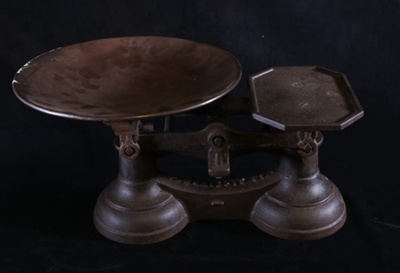Name/TitleWeighing Scales & Pan
About this objectWeighing Scales and Weighing Pan.
Researcher details: John Reed, Volunteer
Standardisation and trust: This Iron scales set with a copper pan, which is accompanied by a set of weights, was used by Aldeburgh cowman Alfred Cracknell. Alfred had a round in the town with a horse and cart supplying fresh fruit and vegetables direct to the residents of Aldeburgh. The produce came from Alfred’s small holding of 1 ½ acres on Saxmundham road.
Scales are synonymous with the dispensation of justice and have weighed the truth and mistruth of trade goods for millennia. The domestication of animals and the advent of farming, during the Neolithic period, resulted in surpluses of certain staples and allowed trade to happen. Civilised trading required the development of consensus units of weights and measurements. Instruments such as scales facilitated honest trading, eased interactions relating to trade, and helped people foster relationships that involved the exchange of more than just goods. Trade approved scales are used ‘to ensure accuracy and reliability in weighing.’
Despite the small scale nature of his one and a half acre smallholding, Alfred’s use of scales hints at his reliability. The scales were in use during WW1, when Alfred’s goods would have been in high demand. Therefore, stringent action and accuracy would have been requited to ensure he gained the trust of the local people and avoided deception and miscommunication.
Trade and markets: The town of Aldeburgh ‘had a small market weekly on Saturdays’ . Alfred, alongside his scales, may have frequented the market supplying vegetables grown upon his land. The nuclei of a small rural town is often its market, which would see different characters and occupations cross paths and attract folks from both countryside and town. Draws of the market include ‘the pleasure of a more personal community-based relationship in shopping’ and the knowledge that you are getting locally sourced goods. A government report from the 2000s includes that markets accentuate ‘the vitality of town centres’ . Not only did markets attract people to shop at the markets themselves, but also to the town centre where there were other shops and facilities, such as the O&C Butcher Clothes shop , resided. Alfred was part of a system that encouraged local people to interact, trade and communicate with each other.
Markets in the modern world and in bigger urban environments often see the mixing of different cultures, ethnicities and religions. The research of Watson and Stubbert titled ‘markets as sites for social interaction’ uses interviews and observations from eight different large English markets to illustrate the social importance of the market.
An example that demonstrates the comradery between different cultures was to be found at Ridley road market where ‘long-established Jewish traders spoke of helping the new Asian traders settle into the market, explaining the customs and practices of market life.’ The example of the Ridley road emphasises the ability of markets to create social harmony. Trading with people who live in the local area, regardless of their background, creates a good feeling. Alfred provided the service of vegetable trade and delivery which would have deeply embedded him in the local community because of his utility.
MakerJAS. Garland & Co.
Period1914 - 1918
Medium and MaterialsScales: Iron
Pan: Copper
Inscription and MarksThe scales and copper pan are stamped: 'JAS. GARLAND & CO.'
MeasurementsDiameter of pan: 230mm
Object Typescales
Object numberSTMEA:76.A.37.4a
Copyright Licence![]() Attribution - Non-commercial (cc)
Attribution - Non-commercial (cc)
PDF FilesFind out more about the Scales.pdf



